It can be challenging to clean Calphalon pans that have been burnt. Don’t be discouraged when there is food stuck to the bottom of your pan, it can be frustrating, but keep trying! You can make your pans look good as new in no time with just a few simple steps and some effort. This guide will show you how to effectively clean your Calphalon pans that have burned on residue, restoring them to their original appearance when purchased. From removing stubborn food residue to restoring even the most heavily charred surfaces, follow these tips and tricks for getting your cookware back into shape.
What is a Calphalon Pan?
Calphalon pan refers to a cooking utensil that is manufactured using anodized aluminum. This type of material is known for its superior heat conduction and durability, making it ideal for all types of cooking. Furthermore, the non-stick surface simplifies the cleaning and upkeep process.
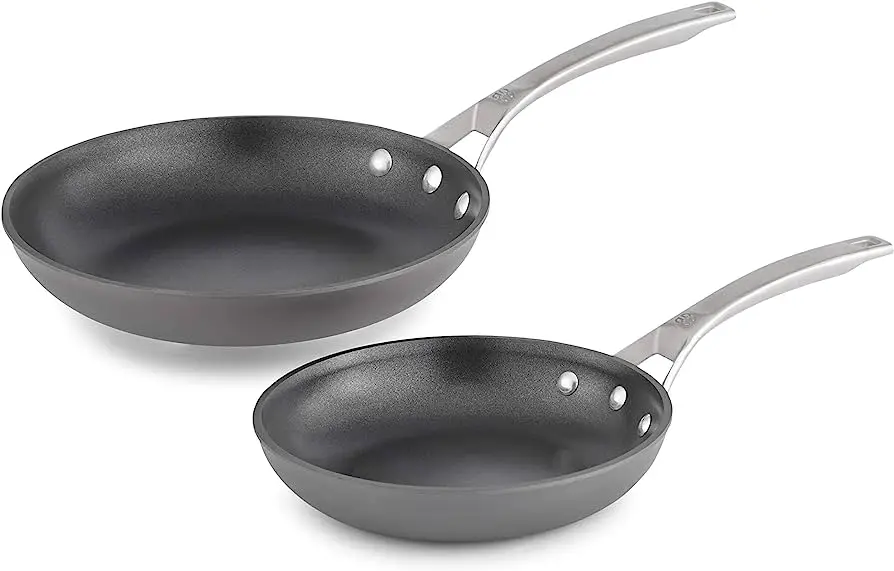
However, due to the construction of these pans, they can become burnt if not properly cared for or used incorrectly. [1]
Regular Cleaning for Hard Anodized Calphalon Pans
Calphalon’s hard anodized cookware is designed to withstand frequent use in the kitchen. All pans need to be regularly cleaned in order to maintain their appearance and keep them free from residue. To clean Calphalon pans that have a hard anodized surface:
- Things You’ll Need
- Calphalon pans
- Sponge or cloth
- Mild dishwashing detergent
- Baking soda
- White vinegar
- Plastic scraper
- Pot scrubber
- Instructions
Add a few squirts of dish soap into the pan filled with water.
Let it sit in the sink or on your stovetop overnight, preferably 8-12 hours.
To get rid of any burnt residue on the bottom of the pan, try using a gentle scrubber that won’t scratch the surface. To tackle difficult spots, use a gentle-bristled brush such as a toothbrush.
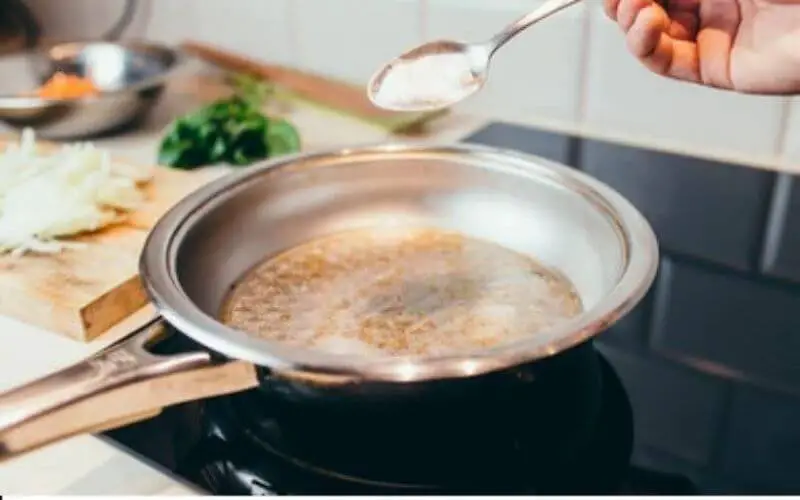
After rinsing the pan with hot water, check if there is any leftover residue.
Make sure to completely dry it before storing or using it again.
After waiting for 30 minutes, use a non-abrasive scrubber to scrub and rinse it. Continue repeating the process until the pan is completely clean.
To prevent your Calphalon pan from burning in the future, use medium heat or lower while cooking.
This will avoid any food sticking to the bottom of the pot or pan. To prevent the food from sticking and burning onto the pan, it is important to stir it frequently.
Place a silicone pot holder or mat between the pan and stove top when cooking for added protection.
This will help prevent your pans from burning by keeping the heat away from direct contact with them.
To prevent residue buildup and burning, clean your Calphalon pans right after each use. Make sure to follow the cleaning and care instructions provided by the manufacturer to avoid any damage to your pans. [2]
Deep Cleaning for Burnt Calphalon Pans
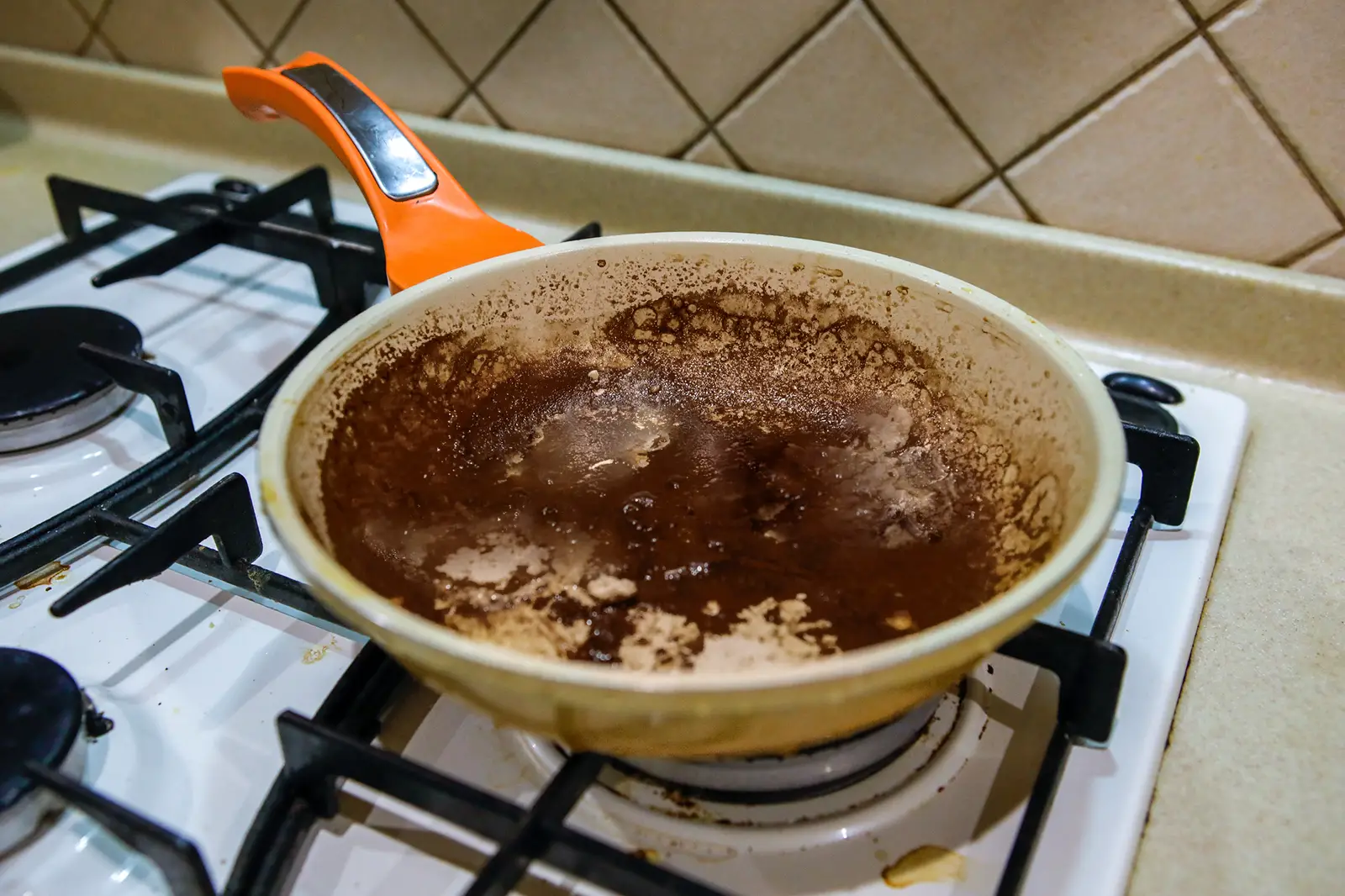
If you have tried the cleaning methods mentioned above and the burnt residue is still present, it is necessary to perform a more thorough cleaning. Depending on your pan’s material, there are several ways to deep clean your Calphalon cookware.
- Things You’ll Need
- Soft sponge or cleaning cloth
- Baking soda
- White vinegar
- Hot water
- Dish soap
- Instructions
To fill the pan, add some drops of liquid dish soap into hot water. Let the pan sit for 20-30 minutes to give the soap enough time to penetrate the burnt food particles.
To get rid of any leftover burnt food, use a soft scrubbing pad and gently clean the bottom of the pan.
Use a clean, dry cloth to rinse and dry the pan.
To remove stubborn burnt particles, simply pour enough white vinegar to cover the bottom of the pan and let it sit for 10-15 minutes. The vinegar’s acidity will aid in dissolving any leftover food debris. Then use the scrubbing pad to loosen them before rinsing with hot water.
To remove burnt residue, soak the pan in a solution of 1 cup baking soda and 1 gallon hot water for 30 minutes. The baking soda’s alkalinity will assist in disintegrating the particles, allowing for easier removal when scrubbing with a gentle pad or sponge.
After removing the burnt residue, make sure to rinse and dry the pan thoroughly. This will ensure that the pan is ready to be used.
To remove particularly stubborn burnt-on food from pans, try using a commercial cleaner like Bar Keepers Friend or CLR cleanser that is designed specifically for cleaning burnt cookware. [3]
Baking Soda Method
The method of using baking soda to clean burnt Calphalon pans is straightforward and successful. To begin, fill the pan with water and then add a few tablespoons of baking soda.
Allow the mixture to rest for approximately 30 minutes before heating it on the stovetop until it boils. Before pouring out the solution, turn off the heat and allow it to cool down completely after boiling.
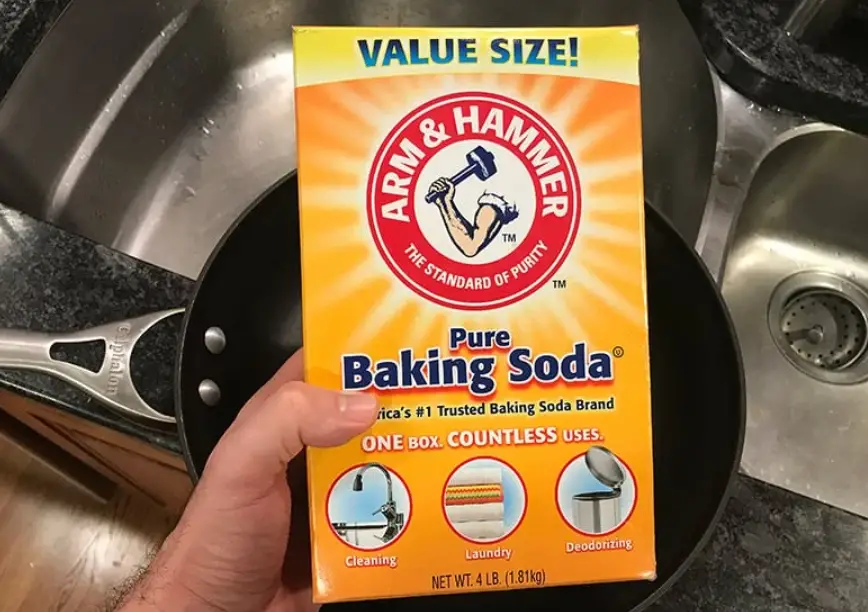
Afterward, utilize a scrubbing pad that isn’t abrasive to softly eradicate the burnt-on residue from the pan. Be sure not to scrub too hard or you could damage the surface of your Calphalon cookware.
After finishing, rinse with hot water and add a few drops of dish soap to achieve a thoroughly clean finish.
Your Calphalon cookware should now be restored to its former glory and ready for cooking. If you use the baking soda method on a regular basis, you can keep your pans clean and prevent burnt-on residue.
White Vinegar Method
Start by filling the pan with one quart of water and two tablespoons of white vinegar. Place the pan on a stovetop burner set between medium-high and high heat and bring to a boil. After boiling the mixture, let it sit in the pan for 10 minutes and then rinse it out with warm soapy water. Scrub any stubborn bits of residue with a metal scrubber or brush. Before storing the pan for future use, make sure to rinse and dry it completely.
Salt and Lemon Method
If the burnt Calphalon pan seems to be really stuck, a salt and lemon mixture can help break it up. Start by sprinkling a layer of salt over the bottom of the pan. Next, cut a lemon in half and use its juice to squeeze over the layer of salt. Wait for 30 minutes before using a sponge to scrub it off. You should be able to easily remove the burnt residue with this method. Be sure to rinse away the lemon and salt mixture afterwards. Repeat as needed for tough spots. [4]
Key Tips for Cleaning Calphalon Pans
Start by soaking the pan in hot, soapy water for 15-20 minutes. Using this will aid in loosening burnt-on food particles or stuck residue.
Scrub the burnt parts of the pan with a nonabrasive scrubbing sponge. If needed, you can use a steel wool pad to clean the pan, but be careful not to cause any damage.
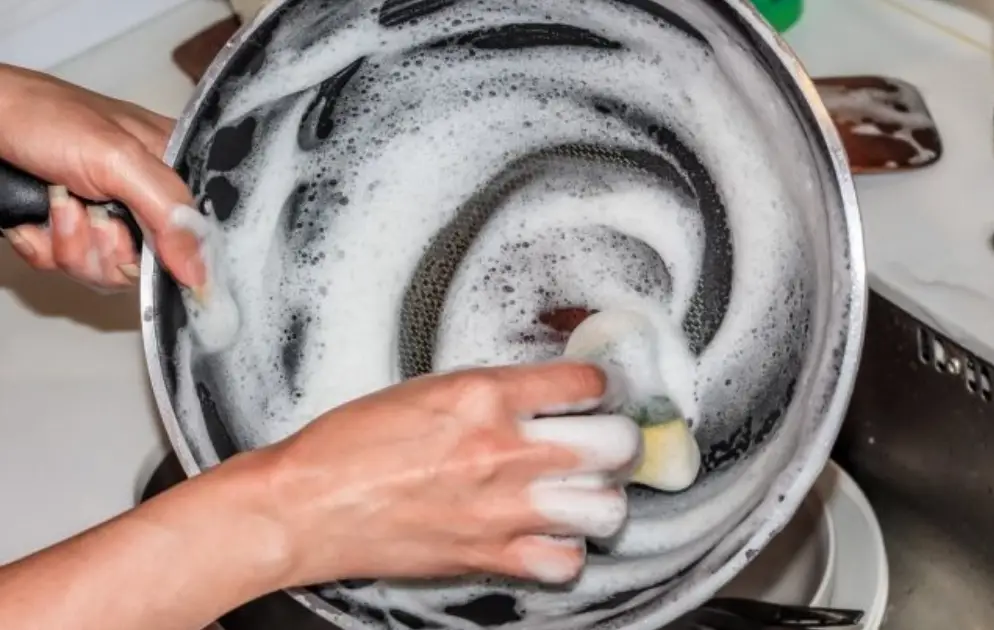
After you finish scrubbing the pan, make sure to rinse and dry it completely.
To remove stubborn stains on your pan’s surface, make a paste by mixing baking soda and water. Apply the mixture to the stained area. Wait for approximately 10 minutes before removing the scrub.
To achieve a more thorough cleaning, pour some water into your pan and mix in a few tablespoons of either white vinegar or lemon juice. Heat the mixture until it starts boiling, then lower the heat and let it simmer for approximately 10 minutes. Using this method will not only sanitize the pan but also effectively remove any burnt residue that could be present.
After completion, rinse the pan thoroughly and use a clean cloth to dry it. Following these steps should make your Calphalon pan appear brand new. [5]
FAQ
How do you clean a badly burnt non-stick pan?
The first step to cleaning a badly burnt non-stick pan is to assess the damage. To restore a heavily burned pan surface, you may need to take extreme measures such as boiling or using chemical cleaners.
In case the burn marks are not severe, you can try cleaning them with a damp cloth and mild dish soap. If scrubbing doesn’t remove the burn marks completely, try using a paste of baking soda and water as a natural cleaning solution. To use, apply the paste to the area that needs to be treated, wait for 15 minutes, and then gently scrub with a soft brush or cloth.
If you encounter stubborn stains, you might want to try using more powerful abrasive cleaners like Bon Ami or Bar Keeper’s Friend. You should always follow the manufacturer’s instructions for cleaning your particular pan.
Is it safe to use a scratched Calphalon pan?
Scratches in a Calphalon pan can cause food to stick and may decrease the lifespan of a Calphalon pan. It’s recommended that you avoid using scratched or worn out pans because they are not as safe to use for cooking due to their weakened state. The best option is to replace your scratched Calphalon pan with a new one. Additionally, it is not recommended to use metal scouring pads or abrasive cleaners on a Calphalon pan as this could further damage the surface of the pan.
If the scratch on your Calphalon pan is not too deep, you can attempt to clean it using a non-abrasive cleaner and hand-wash it using warm water and soap. Make sure to thoroughly rinse the pan and then use a soft cloth to dry it. Also, check the manufacturer’s instructions for additional information on cleaning and maintaining your Calphalon cookware.
How do you clean a badly burnt stainless steel pan?
Cleaning a badly burnt stainless steel pan with just soap and water can be challenging. To remove the burnt-on residue, you’ll need to first heat the pan up on the stove for about 5 minutes. Using this will aid in loosening particles stuck on the pan’s surface. After heating the pan, let it sit for a few minutes and then add a cup of white vinegar. Using this will assist in breaking down any remaining food particles, grease, or burnt-on residue. After minutes, you can use a non-abrasive scrubber to gently remove the burnt-on residue. After using vinegar, make sure to rinse with hot water thoroughly to eliminate any remaining residue.
If the burnt-on residue is still present, repeat the cleaning process until it’s completely removed.
Finally, dry your pan with a clean cloth and store for future use.
When should I throw away my Calphalon pans?
If your Calphalon pans have burns or are warped due to heat, you need to replace them. Warped pans can cause food to cook unevenly, while burned pans may impart a bitter or unpleasant flavor in your food. Pans with heavily discolored surfaces should also be replaced as they will not conduct heat properly and could become a hazard. If you have been using harsh cleaning methods or mishandling your pan, and as a result, the non-stick coating has been scratched off, then you should replace the pan.
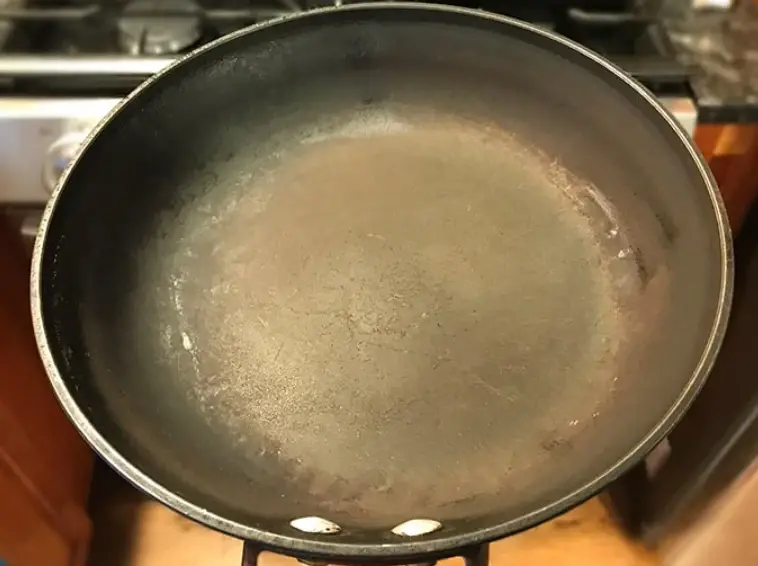
If you do choose to continue using these pans, keep an eye out for any chips or cracks that might form and throw away the pan when these occur. To ensure the longest-lasting Calphalon pans, choose ones with an anodized or hard-anodized surface.
Does baking soda remove burnt food from the pan?
Need help removing burnt food from your pan? Look no further than baking soda! Simply mix 3 parts baking soda with 1 part water to create a paste, then apply it generously to the inside of the pan. Wait 30 minutes before scrubbing with a nylon scouring pad or brush. Say goodbye to stubborn burnt-on messes with this easy cleaning hack. Get rid of those stubborn burnt bits on your pan with ease!
Simply rinse the pan with warm water and use a sponge or dishcloth to scrub away any remaining residue. Finish by rinsing the pan with hot water and drying it before use. Repeat the process, if needed, until all burnt food is gone.
Will vinegar ruin a nonstick pan?
Discover a simple solution for cleaning burnt residue off your Calphalon nonstick pan – vinegar. Contrary to popular belief, vinegar won’t harm your pan. Instead, it’s a useful tool for removing stubborn stains. To use, mix equal parts of white vinegar and water, heat in the microwave for several minutes, and clean away the residue with ease. To remove burnt residue from your Calphalon pan, try this safe and effective method.
Firstly, heat the pan, then use a nonabrasive sponge to gently scrub off the residue. Afterward, rinse the pan thoroughly with hot water and dry it off using a soft cloth. This method is safe for all types of Calphalon pans, including non-stick ones. Your pan will look as good as new in no time.
How do you clean a burnt non-stick pan without vinegar?
If you are looking for an effective way to clean a burnt non-stick pan without using vinegar, there are several options at your disposal. One of the simplest and most straightforward methods is to fill the pan with water and bring it to a boil. After boiling for several minutes, turn off the heat and allow the remaining water to cool. To remove burnt residue from your cookware, start by cooling it down. Then, use a sponge or soft bristled brush to scrub off any remaining burnt bits.
If that doesn’t do the trick, try this: mix equal parts baking soda and warm water to make a paste. Apply the mixture to the affected area and let it sit for a few minutes before scrubbing the burnt residue away with a sponge or brush. Say goodbye to burnt-on messes with this easy solution.
If you’re looking for an alternative cleaning solution, give lemon juice a go. Simply mix equal parts of lemon juice with warm water. Spread the mixture onto the affected area of the pan and leave it for 15 minutes. Then, use a soft-bristled brush or sponge to gently scrub off the burnt residue.
Afterwards, give the pan a thorough wash with warm, soapy water to remove any lingering grime or debris.
Can you still use a burnt non-stick pan?
Often, using burnt pans is not safe. You can still use a non-stick pan that has been burnt for some cooking tasks, but be aware that the coating can come off easily. If you ingest the coating, it can be a health hazard. To avoid further damage to a burnt non-stick pan, it’s recommended to use oils or fats when cooking at low temperatures. Also, it’s best to avoid any acidic ingredients like citrus fruits or tomatoes, which may cause the remaining coating to break down. Being careful while cleaning the pan is crucial because excessive scrubbing can further damage the remaining non-stick layer.
How long do Calphalon nonstick pans last?
If you take care of them properly, Calphalon nonstick pans can last for many years because they are generally very durable. As with any cookware, the lifespan of a Calphalon pan depends on how often it is used, how well it is maintained, and other factors such as storage conditions and frequency of use. In order to maximize the benefits of your Calphalon nonstick pan, it is necessary to take proper measures to clean and maintain it. Cleaning burnt pans can be especially tricky since stuck-on food particles can make them harder to clean. Here are some tips to help you keep your Calphalon nonstick pans in good condition:
To clean a dirty or burnt pan, first soak it in hot soapy water for an hour to loosen any stuck-on food particles.
Use a nylon scrubbing pad or non-abrasive sponge to remove the loosened food particles from the pan’s surface.
To clean the pan, run hot water over it and then wipe it dry with a clean cloth or paper towel.
If you still have burnt-on residue, you can make a paste using baking soda and water, and then apply it to the affected area. Wait for a few minutes before using a moist sponge to wipe it off.
Finally, coat your pans with cooking oil or spray them lightly with cooking spray to help prevent sticking in the future.
How long do Calphalon hard-anodized pans last?
The Calphalon hard-anodized pans are made for longevity. You can make these pans last for years with the right care and maintenance. The lifespan of a Calphalon hard-anodized pan varies based on how often it is used and how well it is taken care of. Regular cleaning and seasoning is necessary to keep your pan in top condition, allowing it to stay properly seasoned and ready for use. To make it last longer, be sure to wash it by hand using warm soapy water after every use, and thoroughly dry it before storing. It’s important not to use metal utensils or harsh cleaners on your pan as they can cause damage to the surface. To ensure a prolonged usage of your Calphalon hard-anodized pan, please follow these steps.
Useful Video: How to Clean Calphalon Nonstick Cookware
Conclusion
Cleaning a burnt pan is not an easy task, but it can be done. It requires patience and the right supplies. To begin, immerse the pan in hot water mixed with dish soap for a minimum of one hour. If there are any food particles stuck, you may use a sponge or scrubbing pad to remove them. To treat stubborn burns, create a mixture of baking soda and water and apply it to the affected area. Finally, avoid using harsh abrasives or scouring pads on your Calphalon pans as this could damage the finish and reduce its non-stick properties.
References
- https://boatbasincafe.com/how-to-clean-calphalon-pans/#:~:text=Just%20take%20a%20tablespoon%20of,and%20scrub%20the%20pan%20carefully.
- https://www.kitchensity.com/cookware/how-to-clean-burnt-calphalon-pans/
- https://kitchenoa.com/how-to-clean-burnt-calphalon-pans/
- https://familykitchennow.com/how-to-clean-calphalon-pans/
- https://prudentreviews.com/how-to-clean-calphalon-hard-anodized-pans/

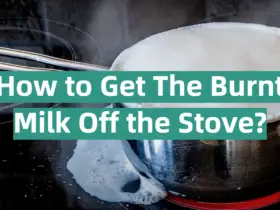


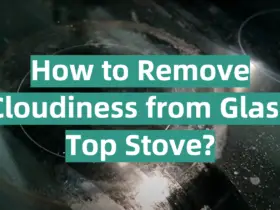
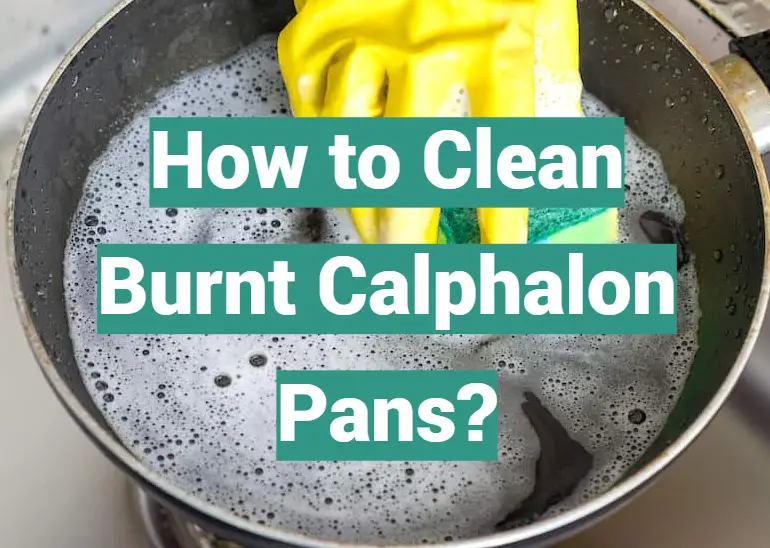
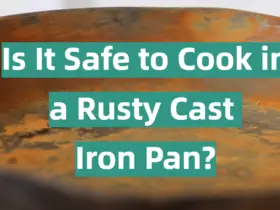
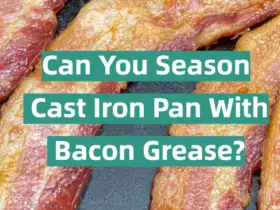
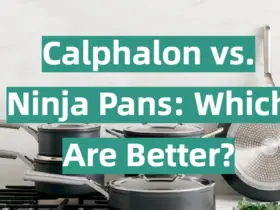
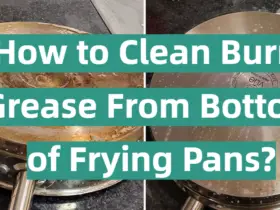
Leave a Reply